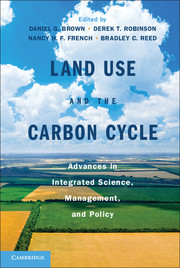Book contents
- Frontmatter
- Contents
- Chapter Authors and Affiliations
- Acknowledgments
- Acronyms
- Part I Introduction
- Part II Measurement and Modeling
- 5 Remote Sensing for Mapping and Modeling of Land-Based Carbon Flux and Storage
- 6 Atmospheric Observations and Inverse Modeling Approaches for Identifying Geographical Sources and Sinks of Carbon
- 7 Limitations, Challenges, and Solutions to Integrating Carbon Dynamics with Land-Use Models
- 8 Modeling for Integrating Science and Management
- Part III Integrated Science and Research Applications
- Part IV Land Policy, Management, and the Carbon Cycle
- Part V Synthesis and Future Directions
- Index
- Plate Section
- References
5 - Remote Sensing for Mapping and Modeling of Land-Based Carbon Flux and Storage
Published online by Cambridge University Press: 05 February 2013
- Frontmatter
- Contents
- Chapter Authors and Affiliations
- Acknowledgments
- Acronyms
- Part I Introduction
- Part II Measurement and Modeling
- 5 Remote Sensing for Mapping and Modeling of Land-Based Carbon Flux and Storage
- 6 Atmospheric Observations and Inverse Modeling Approaches for Identifying Geographical Sources and Sinks of Carbon
- 7 Limitations, Challenges, and Solutions to Integrating Carbon Dynamics with Land-Use Models
- 8 Modeling for Integrating Science and Management
- Part III Integrated Science and Research Applications
- Part IV Land Policy, Management, and the Carbon Cycle
- Part V Synthesis and Future Directions
- Index
- Plate Section
- References
Summary
Introduction
An essential aspect of carbon (C) accounting is the development of methods and technologies for measurement and monitoring of C pools and fluxes. Forest and agricultural systems are key to the C cycle, as they hold and rapidly exchange large amounts of C, and human-influenced dynamics of C in these systems are very large. Wetlands, streams, and rivers are important reservoirs and exchange points for C, with C in land and hydrologic systems vulnerable to land-use impacts and other natural disturbance forces. In the context of climate change, the sizes of C pools and magnitudes of C fluxes (see Chapter 2) need to be both well understood for modeling purposes and accurately monitored to quantify and attribute changes driven by land-change processes and confounded by climate-change forces.
Direct-measurement methods for C accounting, such as a ground-based inventories, can be inappropriate for covering large landscapes to document extensive C pools or for repeating measurements needed to adequately account for C dynamics. However, if properly deployed, remote sensing systems can be used to provide the spatially synoptic and temporally frequent coverage needed to document land conditions and changes over time (Cohen and Goward 2004; Houghton and Goetz 2008). Remote sensing tools and techniques have developed since the first airborne sensors (photographic cameras) were deployed in the early 1900s. They have progressed from simple passive recording devices to advanced passive and active sensing systems operating from airborne and spaceborne platforms. Remote sensing science includes the data collection technologies and data analysis techniques developed to use remotely sensed data within the framework of spatial data analyses.
- Type
- Chapter
- Information
- Land Use and the Carbon CycleAdvances in Integrated Science, Management, and Policy, pp. 95 - 143Publisher: Cambridge University PressPrint publication year: 2013
References
- 1
- Cited by



